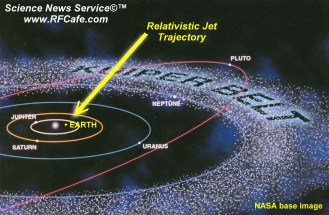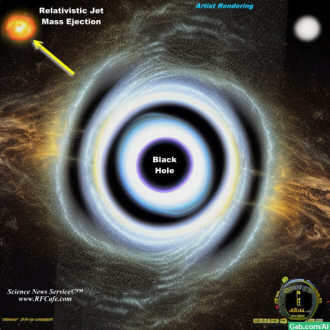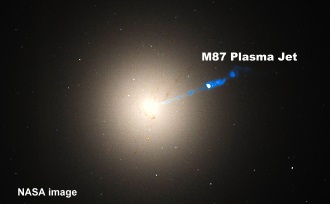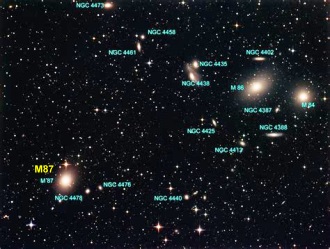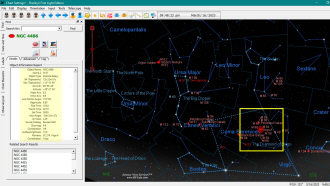Potentially Damaging Black Hole Mass Ejection Approaching Earth Orbit
|
|
April 1, 2023 Dateline 5:45 AM UTC | Geneva, Switzerland Potential EMP or Carrington Event Scenario At 04:23 UTC, a consortium of astronomers using the Even Horizon Telescope (EHT) reported confirmation of the presence of a massive cluster of highly energetic deep space particles heading toward Earth orbit. It is believed based on a time sequence of measurements over the past 12 hours that the mass originated in the area of a supermassive black hole in the M87 galaxy (Messier object), approximately 54 light years distant. Currently crossing inside the extreme outer boundary of the Kuiper Belt region, measurements have determined there is a very strong concentration of energy in the 1.225 GHz (1225 MHz) and 2.428 GHz (2428 MHz) electromagnetic spectrum. While the nature of such particle clusters generally consists of a wideband dispersion of frequencies, these two wavelengths are of great concern because 1.225 GHz is very close to the 1.2276 GHz (1227.6 MHz) "L2" signal which is a critical component of the Global Positioning System (GPS) navigation signal, and 2.428 GHz falls within the 2.4 through 2.5 GHz Industrial, Scientific, and Medical (ISM) band used worldwide for unlicensed wireless communications.
Relativistic Jet Earth Orbit Trajectory. Black Hole Relativistic Jet artist rendering showing break-away mass ejection.
M87 Galaxy location in Virgo Cluster. Virgo Cluster of galaxies sky map. Highly accurate measurements have not been made yet of the exact trajectory or energy levels worst case scenario since the antenna array's pointing capability has been exceeded as the result of the Earth turning away from the source. Approximately eight more hours will be needed to re-acquire the signal. Other NEO monitoring stations will monitor the progress, but no others have the measurement capabilities for precise determination of parameters. Scientists monitoring the situation warn that if data shows the energy content levels are as first observed, a cataclysmic communications disruption may ensue which may in the best case simply disrupt local and long distance communications, and in the worst case cause damage to sensitive components and systems. The USAF and other countries' orbiting satellites could be forced to assume a self-preservation mode where reception and transmission is suspended and antennas are pointed away from the relativistic jet energy source. In the event of the latter scenario, a message will be transmitted via each country's Emergency Broadcast System (EBS) advising that ground-based receivers (GPS, cellphones, cordless phones, WiFi, Bluetooth, wireless security, SmartHome devices, etc.) be powered off until an all-clear is given. Citizen, corporate, and governmental preparations should be made immediately to take whatever actions are recommended. Law enforcement and military oversight will be placed on high alert and be granted the equivalent of marshal law during the EMP-like (electromagnetic pulse) environment characteristic of a thermonuclear attack. Monitoring of friendly and hostile nuclear activity, as well as intercontinental ballistic missile (ICBM) status will remain under intense scrutiny to prevent false attack alerts and/or to assure full-force reaction to an intentional launch. A less catastrophic possibility is a Carrington Event-like occurrence where a powerful coronal mass ejection (CME) that occurred in September 1859 wreaked havoc with telegraph and electric power transmission systems as extremely high currents were induced in the long, unprotected lengths of copper conductors. It is named after the English astronomer Richard Carrington, who observed the event and was the first to connect it with a flare on the sun's surface. The Carrington Event was one of the largest CMEs ever recorded, with a estimated speed of about 2,000 kilometers per second. It caused a massive geomagnetic storm that was felt around the world, and resulted in widespread disruptions to telegraph systems. Telegraph operators reported a number of strange phenomena, including sparks and shocks from the equipment, and the transmission of messages even after the power had been turned off. Another CME brownout occurred on March 13, 1989, as a result of a powerful coronal mass ejection (CME) that hit Earth. The CME was caused by a solar flare that occurred on March 9, 1989, and was one of the largest ever recorded. The CME caused a massive geomagnetic storm that affected power grids and communication systems around the world. In North America, the most significant impact was felt in Quebec, Canada, where the electrical grid was overwhelmed by the surge of electrical current induced by the geomagnetic storm. This caused a widespread power outage that lasted for several hours and affected over 6 million people. The disruption to the power grid was caused by the interaction between the CME and the Earth's magnetic field. The CME caused a surge of electrical current in power lines, which overloaded transformers and other equipment, leading to the widespread power outages. The CME brownout event highlighted the vulnerability of our modern technological infrastructure to space weather events. Since then, efforts have been made to improve our ability to detect and predict CMEs, and to develop strategies for mitigating their impact if and when they occur. Similar to a coronal mass ejection (CME) originating from our nearest star, the sun, a "relativistic jet" of highly energetic particles often is observed tearing loose from the extremely rapidly rotating mass of interstellar dust being gravitationally drawn into the black hole core. Relativistic jets are extremely powerful beams of plasma that are ejected at high velocities from the vicinity of black holes. By virtue of Albert Einstein's famous e=mc2 relationship between mass and energy, as the material accelerates and heats up part of its mass is converted to energy whose electromagnetic spectrum is determined by both the nature of the mass (its atomic makeup) and the speed of the particles. The world's leaders urge patience and rational behavior throughout this event, which is the first experienced since the beginning of the electric / electronic age. The detection of black-hole-generated relativistic jets is typically done using telescopes that can observe the radio or X-ray parts of the electromagnetic spectrum. Radio telescopes can detect synchrotron radiation produced by electrons spiraling around magnetic fields in the jet, while X-ray telescopes can observe the high-energy radiation produced by the interaction between the jet and the surrounding gas and dust. Detection of this relativistic jet is the result of Near-Earth Object (NEO) program, which is the process of identifying asteroids, comets, and other small bodies that are on a trajectory to pass close to Earth or potentially impact our planet. The goal of NEO detection is to identify these objects early and accurately, in order to assess the risk of impact and potentially take measures to prevent a collision. NEO detection is typically carried out using ground-based telescopes, which can detect the reflected sunlight from these objects as they move through space. These telescopes use a variety of detection methods, including imaging and spectroscopy, to identify and track NEOs. In addition to ground-based telescopes, space-based telescopes such as the Wide-feld Infrared Survey Explorer (WISE) and the Near-Earth Objet Camera (NEOCam) have also been used to detect NEOs. Once a NEO is detected, its orbit is calculated to determine whether it poses a risk of impact with Earth in the near future. This is done using computer simulations that take into account the gravitational interactions between the NEO, the Earth, and other celestial bodies in the solar system. If a NEO is found to pose a significant risk of impact, various measures can be taken to prevent a collision. These include using spacecraft to deflect the NEO's trajectory, or detonating a nuclear device near the NEO to break it up into smaller pieces that pose less of a threat. The Kuiper Belt is a region of our solar system located beyond the orbit of Neptune, about 30 to 50 astronomical units (AU) from the Sun. It is named after Dutch-American astronomer Gerard Kuiper, who first proposed the existence of a region beyond Neptune where many small, icy bodies could be found. Interstellar radio interference refers to radio signals that are emitted by natural and artificial sources outside our Solar System, which can interfere with radio signals from astronomical objects. Some examples of interstellar radio interference sources are: Pulsars: Pulsars are highly magnetized, rotating neutron stars that emit beams of electromagnetic radiation. The signals emitted by pulsars can interfere with radio signals from other astronomical objects. Supernova remnants: Supernova explosions produce shock waves that can accelerate charged particles to high energies, creating synchrotron radiation that can interfere with radio signals. Cosmic rays: Cosmic rays are high-energy particles that travel through space and can interfere with radio signals. Galactic background radiation: The Milky Way galaxy emits a diffuse background of radio waves, which can interfere with radio signals from other astronomical objects. Solar flares: Solar flares are eruptions of plasma from the surface of the Sun, which can produce bursts of radio emission that can interfere with radio signals from astronomical objects. Satellites: Artificial satellites in orbit around Earth can emit radio signals that can interfere with radio observations of astronomical objects. Terrestrial radio sources: Radio signals from Earth-based radio stations and other communication systems can also interfere with radio observations of astronomical objects. These sources of interstellar radio interference are a major concern for astronomers, as they can make it difficult to observe and study astronomical objects in the radio part of the electromagnetic spectrum. To minimize the impact of interference, astronomers use specialized techniques such as frequency filtering and interferometry to isolate and study the radio signals emitted by astronomical objects. Interstellar radio interference at 2.4 GHz is possible, but it is not usually a significant concern for astronomical observations because most radio telescopes do not operate at this frequency. The 2.4 GHz frequency band is widely used for communication and wireless networking on Earth, and as a result, there is a significant amount of radio interference from terrestrial sources at this frequency. However, some astronomical observations are carried out at 2.4 GHz, such as studies of the interstellar medium and searches for extraterrestrial intelligence (SETI). In these cases, interference from terrestrial sources can be a significant problem, as it can mask or distort the signals from astronomical sources. To minimize the impact of interference, radio telescopes that operate at 2.4 GHz typically use sophisticated filtering and interference rejection techniques, such as matched filtering and adaptive interference cancellation. These techniques can help to improve the sensitivity and accuracy of radio observations at 2.4 GHz, but they cannot completely eliminate the effects of interference. In general, the choice of observing frequency for a particular astronomical study depends on a variety of factors, including the properties of the target object, the sensitivity and resolution of the telescope, and the level of interference from terrestrial and interstellar sources at different frequencies. A coronal mass ejection (CME) is a massive burst of plasma and magnetic field that is ejected from the sun's corona, the outermost layer of the sun's atmosphere. CMEs can release billions of tons of material into space, traveling at speeds of several million miles per hour. CMEs are often associated with solar flares, which are sudden and intense releases of energy from the sun's surface. During a solar flare, a large amount of energy is released in the form of X-rays and ultraviolet radiation. This energy can heat the sun's corona to millions of degrees, causing it to expand and release plasma and magnetic fields. When a CME is directed toward Earth, it can cause a number of effects. The magnetic field associated with the CME can interact with the Earth's magnetic field, causing a geomagnetic storm. This can lead to disruptions in radio communication, power grids, and other technological systems. In addition, CMEs can cause beautiful auroras, or Northern and Southern Lights, as the charged particles from the CME interact with the Earth's upper atmosphere. While CMEs can pose a risk to our technological infrastructure, they also provide valuable information about the sun and its behavior. Studying CMEs can help us better understand the sun's magnetic field, the dynamics of the corona, and the ways in which the sun affects the space environment around us. Power grid operators have implemented measures to reduce the risk of widespread blackouts in the event of a major CME, such as isolating transformers and other critical components of the power grid, and improving the response time to power outages. Additionally, space weather monitoring and forecasting has become an important aspect of space science, with multiple international organizations working to improve our understanding of the sun and its impact on our planet. Hardening the power grid against CMEs (coronal mass ejections) and now relativistic jets involves implementing measures to reduce the risk of power outages and mitigate their impact in the event of a severe space weather event. Some of the ways in which the power grid can be hardened against CMEs include: Isolation of critical components: Transformers and other critical components of the power grid can be isolated and protected from the effects of a CME by using surge protectors, circuit breakers, and other protective devices. This can help prevent the surge of electrical current induced by a geomagnetic storm from overloading the grid and causing widespread outages. Upgrading power grid infrastructure: Modernizing the power grid infrastructure can help make it more resilient to space weather events. This may involve replacing outdated equipment with more robust and reliable components, such as high-temperature superconducting wires that are less susceptible to damage from electrical surges. Improved monitoring and forecasting: Improving our ability to detect and predict CMEs can help power grid operators prepare for and respond to space weather events. This may involve using advanced space weather monitoring and forecasting systems, such as the Space Weather Prediction Center operated by the National Oceanic and Atmospheric Administration (NOAA). Developing emergency response plans: Developing emergency response plans and conducting drills to prepare for potential space weather events can help power grid operators respond quickly and effectively in the event of a severe CME. Overall, hardening the power grid against CMEs is a complex and ongoing process that requires collaboration between multiple stakeholders, including power grid operators, government agencies, and the scientific community. A CME (coronal mass ejection) can cause disruption to amateur radio communications, which is very often plays a key role during times of emergency when traditional forms of communications are destroyed or hindered during natural and/or manmade activity. This is because a CME can cause disturbances in the Earth's ionosphere, which can affect the propagation of radio waves. Radio waves are normally reflected back to Earth by the ionosphere, but during a geomagnetic storm caused by a CME, the ionosphere can become turbulent, leading to signal attenuation and interference. Amateur radio operators may experience a variety of effects from a CME, including fading of signals, increased background noise, and changes in the direction of signal propagation. In severe cases, communications may be disrupted completely. To mitigate the impact of a CME on amateur radio communications, operators can take a number of steps, such as: Monitoring space weather forecasts: Amateur radio operators can monitor space weather forecasts and alerts to anticipate the impact of a CME on radio communications. Space weather monitoring services such as the Space Weather Prediction Center operated by the National Oceanic and Atmospheric Administration (NOAA) provide real-time information on space weather conditions. Using lower frequencies: During a geomagnetic storm caused by a CME, higher frequency radio waves are more susceptible to attenuation and interference. To improve communication during a CME, amateur radio operators can use lower frequency bands that are less affected by the ionosphere. Using different modes of communication: Different modes of amateur radio communication can be less susceptible to interference from a CME. For example, digital modes such as JT65 and FT8 are less affected by signal fading and can maintain communication over longer distances during a CME. Improving antennas: A well-designed and properly installed antenna can improve the strength and quality of radio signals, even during a CME. Amateur radio operators can invest in high-quality antennas and ensure that they are properly grounded and shielded to reduce the risk of interference. Using low-frequency bands: During a CME, lower frequency radio waves are less susceptible to interference from the ionosphere. Amateur radio operators can use bands such as 40 meters or 80 meters to maintain communication over longer distances. Using digital modes: Digital modes such as JT65 and FT8 can be less susceptible to signal fading and interference, and can maintain communication over longer distances during a CME. Using backup power sources: Amateur radio operators can use backup power sources such as batteries or generators to power their radio equipment in the event of a power outage caused by a CME. Establishing communication protocols: Amateur radio operators can establish communication protocols and procedures to ensure effective communication during a CME. This can include prioritizing emergency traffic, establishing alternative communication channels, and using pre-established frequencies and modes of communication. Overall, while a CME can hinder amateur radio emergency response efforts, with proper preparation and mitigation measures, operators can continue to provide critical communication services during periods of space weather activity. Possible sources of interstellar radio interference at 2.4 GHz include both natural and artificial sources. Some examples are: Galactic background radiation: The Milky Way galaxy emits a diffuse background of radio waves across a wide range of frequencies, including 2.4 GHz. This background radiation can interfere with radio signals from astronomical objects. Synchrotron radiation: High-energy charged particles moving through magnetic fields can emit synchrotron radiation across a wide range of frequencies, including 2.4 GHz. Supernova remnants, pulsars, and other astrophysical objects can produce synchrotron radiation that can interfere with radio signals from other astronomical objects. Terrestrial radio sources: As I mentioned earlier, the 2.4 GHz frequency band is widely used for communication and wireless networking on Earth. This includes Wi-Fi, Bluetooth, and other wireless communication systems, as well as microwave ovens and other appliances that emit radio waves at this frequency. These terrestrial sources can interfere with radio observations of astronomical objects. Satellites: Artificial satellites in orbit around Earth can also emit radio signals at 2.4 GHz, which can interfere with radio observations of astronomical objects. Extraterrestrial communication: Although unlikely, it is possible that advanced extraterrestrial civilizations could use radio waves at 2.4 GHz or other frequencies for communication. If such signals were detected, they would represent a form of interstellar radio interference. In general, the impact of interstellar radio interference at 2.4 GHz on astronomical observations depends on the strength and frequency of the interfering signals, as well as the sensitivity and filtering capabilities of the radio telescope being used. Astronomers have observed and detected black hole mass ejections, also known as relativistic jets, in several objects in the universe. Relativistic jets are extremely powerful beams of plasma that are ejected at high velocities from the vicinity of black holes. The detection of these jets is typically done using telescopes that can observe the radio or X-ray parts of the electromagnetic spectrum. Radio telescopes can detect synchrotron radiation produced by electrons spiraling around magnetic fields in the jet, while X-ray telescopes can observe the high-energy radiation produced by the interaction between the jet and the surrounding gas and dust. One example of a black hole mass ejection the galaxy M87, which is known to host a supermassive black hole at its center. In 2019, astronomers using the Event Horizon Telescope released the first-ever image of the shadow of this black hole, which was produced by the intense gravitational fields in its vicinity. The same observations also revealed the presence of a relativistic jet emanating from the black hole, which was visible as a bright feature extending several thousand light-years from the center of the galaxy. Overall, the detection of black hole mass ejections provides important insights into the nature of black holes and the physical processes occurring in their vicinity. The study of these phenomena is an important area of research in astrophysics, as it can help us understand the evolution of galaxies and the nature of dark matter. M87 is a massive elliptical galaxy located in the constellation Virgo, approximately 55 million light-years away from Earth. It is one of the most massive galaxies in the nearby universe, with a total mass estimated to be around 2.7 trillion times that of the sun. At the center of M87 is a supermassive black hole, which is estimated to have a mass of around 6.5 billion times that of the sun. This black hole is surrounded by a bright, luminous region known as the accretion disk, which is formed from gas and dust that is falling towards the black hole. In 2019, the Event Horizon Telescope collaboration released the first-ever image of the shadow of the black hole in M87. The image was produced by observing the radio emissions from the hot gas surrounding the black hole, which was visible as a bright ring of light around the dark region at the center of the image. The observations also revealed the presence of a relativistic jet emanating from the black hole, which was visible as a bright feature extending several thousand light-years from the center of the galaxy. This jet is produced by the interaction between the black hole's strong gravitational field and the surrounding gas and magnetic fields, which accelerate particles to near-light speeds and eject them along the axis of the jet. The study of M87 and other galaxies hosting supermassive black holes is an important area of research in astrophysics, as it can provide insights into the nature of black holes, the evolution of galaxies, and the structure of the universe on the largest scales. The Event Horizon Telescope (EHT) is a global network of radio telescopes that work together to create a virtual telescope with the resolving power of a dish the size of Earth. It is designed to observe black holes and other extremely compact astrophysical objects. The EHT collaboration includes over 300 researchers from around the world, and uses a technique known as very-long-baseline interferometry (VLBI) to combine the signals from telescopes located in different parts of the world. The technique allows the EHT to achieve a resolution of about 20 micro-arc seconds, which is sufficient to resolve the event horizon of the supermassive black hole at the center of the Milky Way galaxy. One of the main goals of the EHT is to observe the immediate environment of black holes, including the region around the event horizon where the gravitational pull is so strong that even light cannot escape. In 2019, the EHT collaboration released the first-ever image of the shadow of the black hole at the center of the galaxy M87, which was produced by observing the radio emissions from the hot gas surrounding the black hole. The EHT has also observed the supermassive black hole at the center of the Milky Way, known as Sagittarius A*, and has provided important insights into the properties of this object, including its size and the properties of the gas and dust surrounding it. Overall, the EHT is a groundbreaking astronomical instrument that is transforming our understanding of black holes and other compact astrophysical objects. The ongoing observations and analysis by the EHT collaboration are expected to provide important insights into the nature of black holes, the structure of the universe, and the fundamental laws of physics. Black hole mass ejection, also known as a relativistic jet, occurs when a black hole expels a large amount of matter in the form of plasma at close to the speed of light. These jets can extend for hundreds of thousands of light-years and are some of the most powerful phenomena in the universe. Black hole mass ejections are thought to be caused by the intense gravitational fields of the black hole, which can strip gas and dust from nearby stars or the surrounding accretion disk. This material is heated and accelerated to extreme speeds and ejected outwards along the axis of the black hole's rotation. The exact mechanism that produces relativistic jets is still not fully understood, but it is thought to involve the interaction between the intense magnetic fields near the black hole and the plasma in the surrounding environment. Relativistic jets are observed in a variety of astrophysical objects, including active galactic nuclei, quasars, and gamma-ray bursts. These objects are some of the most energetic phenomena in the universe, and studying them can provide insight into the nature of black holes and the evolution of galaxies. GNSS (Global Navigation Satellite System) is a term used to refer to the various satellite-based navigation systems, including GPS (Global Positioning System) operated by the United States, GLONASS operated by Russia, Galileo operated by the European Union, BeiDou operated by China, and several other regional systems. Similar to GPS, GNSS also works by transmitting radio signals from satellites in orbit to receivers on the ground. These signals are used by GNSS receivers to determine their location, velocity, and time. 
Press Release Archives: 2024 | 2023 | 2022 | 2021 |2020 2019 | 2018 | 2017 | 2016 | 2015 2014 | 2013 | 2012 | 2011 | 2010 2009 | 2008 | 2007 | 2006 | 2005 Content is copyright of company represented. Page format, custom text and images are RF Cafe copyright - do not distribute. The GNSS radio signals are transmitted at various frequencies depending on the satellite system. For example, GPS uses L1 (1575.42 MHz) and L2 (1227.60 MHz) bands, while Galileo uses E1 (1575.42 MHz), E5a (1176.45 MHz), E5b (1207.14 MHz), and E6 (1278.75 MHz) bands. GNSS signals also include multiple types of signals, such as: Navigation Message: Provides information on satellite status, ephemeris (satellite orbit information), and time synchronization. Pseudo-random Noise (PRN) code: Unique codes that are used to identify each satellite and also to measure the time delay between the satellite signal and receiver. Carrier signal: The actual radio signal transmitted by the satellite. GNSS signals are essential for many applications, including aviation, maritime navigation, surveying, mapping, and location-based services. They are also used in many scientific and research applications, such as studying the Earth's atmosphere and climate. Science News Service™ is a registered trademark of Science News Service, LLC. All content is the property of Science News Service, LLC, and may not be reproduced without written permission. Copyright 2023. All rights reserved. Written by Kirt Blattenberger for April 1, 2023 (note date). A search of Science News Services, Lyon Legal Justice Partners, and International Brotherhood of Electronics Assemblers turned up no for-real entities by those names. Most of this content generated by ChatGPT artificial intelligence (AI). Read other Science News Service Press Releases:
Posted April 1, 2023 |
 Science News Service
Science News Service
